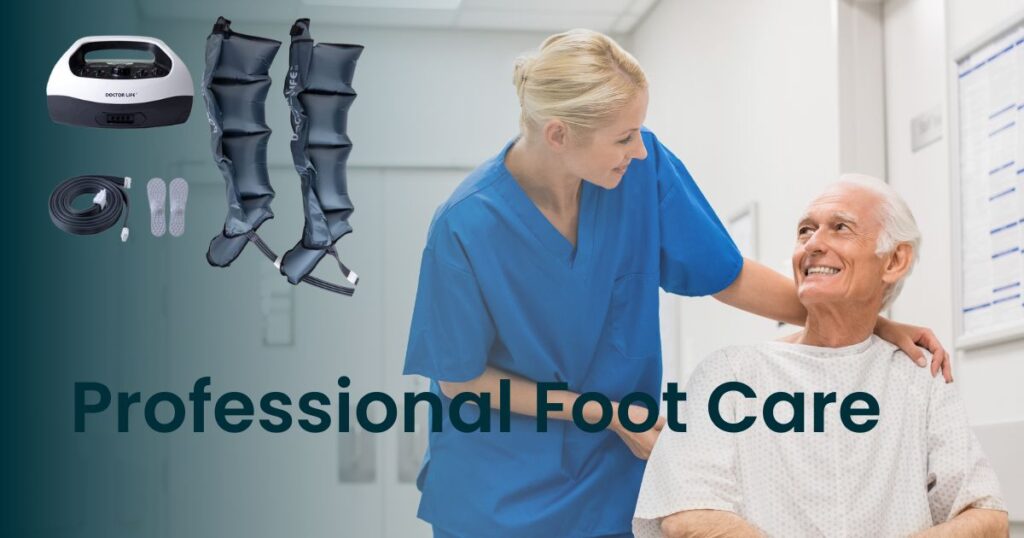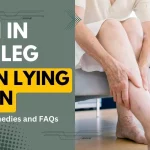As we age, our bodies undergo numerous changes, and our feet are no exception. Our feet carry the weight of our bodies and are subjected to wear and tear every day, making foot health essential to maintaining overall health and mobility. Unfortunately, many people overlook foot health until problems arise. Common foot problems in aging individuals include plantar fasciitis, arthritis, and neuropathy, among others.
In this article, we will explore how to keep feet healthy as you age, including foot care basics, foot exercises, managing foot pain, preventing foot injuries, and the impact of chronic diseases on foot health. We will also discuss the importance of proper footwear, environmental factors, and technology in foot health. By prioritizing foot health, you can maintain your mobility and live a full, active life.
Foot Care Basics
Daily foot hygiene: Proper daily hygiene is essential for maintaining healthy feet. This includes washing your feet with soap and water, paying attention to areas between your toes, and drying your feet thoroughly, especially between your toes.
Moisturizing your feet: As you age, your skin becomes drier and loses elasticity, making it more prone to cracking and injury. Moisturizing your feet daily with a foot cream or lotion can help prevent dryness and cracking.
Trimming your toenails: Keeping your toenails trimmed is important to prevent ingrown toenails and other foot problems. It’s best to trim your nails straight across and avoid cutting them too short or rounding the corners.
Choosing appropriate footwear: Proper footwear is crucial to maintaining healthy feet. When shopping for shoes, look for ones that provide adequate support, cushioning, and room for your toes. Avoid shoes with high heels or pointy toes that can cause foot pain and deformities.
Foot Exercises and Stretches
Importance of foot exercises: Foot exercises and stretches can help improve flexibility, strengthen muscles, and prevent foot injuries. They can also improve balance and stability, which is especially important for aging individuals.
Simple foot stretches: To stretch your feet, you can perform simple exercises such as toe raises, ankle rotations, and calf stretches. These stretches can be done while sitting or standing and can be performed anywhere.
Strengthening exercises for the feet: Strengthening exercises can help improve the muscles in your feet and ankles. These exercises can include toe curls, toe spreads, and heel raises. A physical therapist or podiatrist can recommend specific exercises based on your individual needs.
Recommended frequency of exercises: It’s recommended to perform foot exercises and stretches at least two to three times a week. However, you should consult with a medical professional before starting any new exercise routine, especially if you have pre-existing foot problems or medical conditions.
Managing Foot Pain
Causes of foot pain: Foot pain can be caused by a variety of factors, including injuries, overuse, arthritis, and nerve problems. It’s important to identify the underlying cause of foot pain to determine the appropriate treatment.
Common foot pain conditions: Some common foot pain conditions in aging individuals include plantar fasciitis, bunions, hammertoes, and osteoarthritis. Symptoms can range from mild discomfort to severe pain, and can affect mobility and quality of life.
Treatment options for foot pain: Treatment options for foot pain depend on the underlying cause and severity of the condition. Treatment options can include rest, ice, compression, elevation, pain medications, physical therapy, and in severe cases, surgery.
Preventing Foot Injuries
Common foot injuries in aging individuals: Aging individuals are more susceptible to foot injuries due to changes in foot structure and decreased mobility. Common foot injuries can include sprains, fractures, and falls.
Treating and recovering from foot injuries: If you experience a foot injury, it’s important to seek medical attention promptly. Treatment options can include rest, ice, compression, elevation, and physical therapy. It’s important to follow your healthcare provider’s recommendations for recovery to prevent further injury or complications.
By managing foot pain and preventing foot injuries, you can maintain healthy and mobile feet as you age. In the next section, we’ll discuss the impact of chronic diseases on foot health.
Chronic Diseases and Foot Health

Chronic diseases can have a significant impact on foot health, and it’s important to manage these conditions to prevent foot complications.
Diabetes and foot health: Individuals with diabetes are at a higher risk for foot complications, including neuropathy, poor circulation, and foot ulcers. It’s important to monitor blood sugar levels, maintain good foot hygiene, and seek prompt medical attention for any foot issues.
Arthritis and foot health: Arthritis can cause joint pain, swelling, and stiffness in the feet, which can affect mobility and quality of life. It’s important to manage arthritis symptoms with medication, exercise, and physical therapy.
Peripheral arterial disease and foot health: Peripheral arterial disease (PAD) can cause poor circulation in the feet, which can lead to foot ulcers and other complications. It’s important to manage PAD with medication and lifestyle changes, and to seek prompt medical attention for any foot issues.
By understanding the impact of chronic diseases on foot health, you can take steps to manage these conditions and prevent foot complications. In the next section, we’ll discuss the importance of regular foot exams for maintaining healthy feet.
The Importance of Regular Foot Exams
Regular foot exams are an important part of foot health maintenance, especially as you age. Your healthcare provider can help you identify and address any foot issues before they become more serious.
During a foot exam, your healthcare provider will:
- Check for any changes in skin color, temperature, or texture
- Evaluate your foot and ankle joints for range of motion and flexibility
- Assess your gait and balance
- Examine your toenails and look for signs of infection or fungus
- Check for any areas of tenderness or pain
Based on the results of your foot exam, your healthcare provider may recommend additional testing or refer you to a specialist for further evaluation.
It’s important to schedule regular foot exams with your healthcare provider, especially if you have diabetes or any other chronic conditions that can affect foot health.
Foot Health and Balance
Foot health plays a crucial role in maintaining balance, as the feet are the foundation of the body’s stability. Good foot health can improve proprioception, which is the body’s ability to sense its position in space. In contrast, foot problems such as pain, weakness, and neuropathy can impair balance and increase the risk of falls.
Exercises to improve balance include practicing standing on one foot, heel-to-toe walking, and yoga. These exercises challenge the body’s balance and strengthen the muscles, tendons, and ligaments in the feet and legs. Additionally, wearing proper footwear that fits well and provides adequate support can help improve balance.
Foot Health and Fall Prevention:
Foot health is a crucial aspect of fall prevention, as falls can lead to serious injuries, particularly in older adults. Foot problems such as numbness, weakness, and poor circulation can increase the risk of falls. Therefore, it is essential to maintain good foot health by regularly inspecting the feet for any changes, wearing proper footwear, and seeking treatment for any foot problems.
Tips for preventing falls include staying physically active, getting regular vision and hearing checkups, using assistive devices such as handrails and grab bars, and ensuring a safe home environment. If you experience a fall, it is crucial to seek medical attention immediately, even if you do not feel injured, as some injuries may not be immediately apparent.
Foot Health and Mental Health:
There is a link between foot health and mental health, as foot problems can cause physical discomfort and limit mobility, leading to feelings of depression and anxiety. Additionally, the feet are essential in physical activities, and foot problems can prevent individuals from participating in activities they enjoy, which can also impact mental well-being.
Research has shown a correlation between foot problems and depression, particularly in older adults. Foot problems can limit physical activity, leading to social isolation and reduced quality of life, which can contribute to feelings of depression. Similarly, anxiety can result from a fear of falling or experiencing foot pain.
Foot health is also linked to nutrition, as nutrient deficiencies can impact the health of the feet. Eating a balanced diet with adequate vitamins and minerals can help maintain foot health and reduce the risk of foot problems.
Nutrients that Promote Foot Health:
Several nutrients are essential for maintaining foot health, including calcium, vitamin D, magnesium, and omega-3 fatty acids. These nutrients can help improve bone density, reduce inflammation, and promote healthy circulation, which can prevent foot problems such as plantar fasciitis, arthritis, and neuropathy.
Foods that are harmful to foot health include those that contribute to inflammation, such as processed foods, sugar, and saturated fats. High sodium intake can also cause water retention, leading to swollen feet and ankles.
Supplements that may be beneficial for foot health include calcium, vitamin D, magnesium, and omega-3 fatty acids. However, it is essential to talk to a healthcare professional before taking any supplements, as they can interact with medications and other health conditions.
Professional Foot Care:

Individuals should seek professional foot care if they experience persistent foot pain, swelling, or numbness, as these can be signs of underlying health conditions such as diabetes, arthritis, or neuropathy. Additionally, individuals with chronic conditions such as diabetes should receive regular foot checkups from a healthcare professional to monitor for complications.
Types of foot care professionals include podiatrists, orthopedic surgeons, and physical therapists. Podiatrists are healthcare professionals who specialize in foot and ankle care, while orthopedic surgeons specialize in diagnosing and treating bone and joint problems. Physical therapists can help individuals with foot problems through exercises and other therapies.
Foot care tips for individuals with chronic conditions include keeping the feet clean and dry, wearing properly fitting shoes, inspecting the feet regularly for any changes, and seeking medical attention immediately if any issues arise.
Foot Health and Technology:
Technology has a significant role in foot health, with apps and devices designed to help individuals monitor their foot health, improve mobility, and track progress. For example, wearable devices such as smart socks can track pressure points and monitor for changes that could indicate foot problems.
Foot health apps can help individuals track symptoms, monitor progress, and receive personalized recommendations for improving foot health. Additionally, telemedicine platforms allow individuals to consult with healthcare professionals remotely, which can be particularly beneficial for individuals with limited mobility or who live in rural areas.
The future of foot health technology includes the development of advanced diagnostic tools, such as 3D imaging and machine learning algorithms that can accurately diagnose foot problems and recommend personalized treatments. Additionally, the use of 3D printing technology can create custom orthotics and prosthetics that can improve foot function and mobility.
Foot Health and Age:
Foot health can change as individuals age, with several factors contributing to increased foot problems. These include a decrease in foot padding and natural shock absorption, reduced flexibility, and weakened foot muscles. Additionally, older adults are more likely to have chronic health conditions such as diabetes and arthritis, which can further increase the risk of foot problems.
Common foot problems in older adults include corns, calluses, bunions, and hammertoes. These conditions can be painful and make it difficult to walk or maintain balance, leading to an increased risk of falls and injuries.
Foot care tips for older adults include wearing comfortable and supportive shoes, practicing regular foot hygiene, performing foot exercises, and seeking prompt medical attention if any foot problems arise. Additionally, older adults should have regular foot checkups with a healthcare professional to monitor for any changes or complications.
Conclusion
Maintaining healthy feet as you age is essential for maintaining mobility and quality of life. By practicing good foot hygiene, doing regular foot exercises, and wearing appropriate footwear, you can prevent common foot problems and avoid foot injuries.
If you experience foot pain or notice any changes in your foot health, it’s important to seek prompt medical attention to prevent further complications.
By taking care of your feet and managing any chronic conditions that can affect foot health, you can enjoy an active and healthy lifestyle as you age.
FAQs of How to Keep Feet Healthy as You Age
Q: What happens to your feet as you age?
A: As you age, your feet undergo changes such as decreased cushioning in the foot pads, thinning of the skin, and decreased circulation, which can increase the risk of foot problems.
Q: How can I make my feet strong and healthy?
A: You can make your feet strong and healthy by practicing good foot hygiene, doing regular foot exercises and stretches, wearing appropriate footwear, and seeking prompt medical attention for any foot issues.
Q: How do you keep your feet youthful?
A: To keep your feet youthful, it’s important to maintain good foot hygiene, do regular foot exercises and stretches, wear appropriate footwear, and manage any chronic conditions that can affect foot health.
Q: What are common foot problems in older adults?
A: Common foot problems in older adults include arthritis, plantar fasciitis, bunions, corns, calluses, and foot ulcers.
Q: What are 7 common foot problems?
A: Seven common foot problems include plantar fasciitis, heel spurs, bunions, corns, calluses, toenail fungus, and athlete’s foot.
Q: What are the two causes of most foot problems?
A: The two main causes of most foot problems are improper footwear and neglect of foot care. It’s important to wear appropriate footwear and practice good foot hygiene to prevent foot problems.



